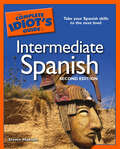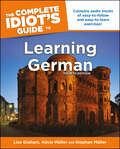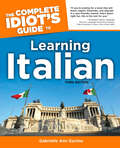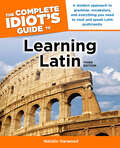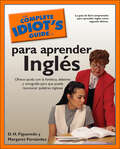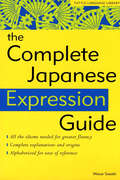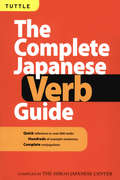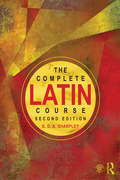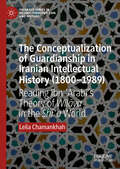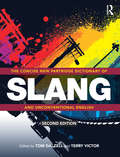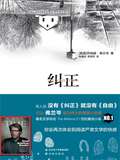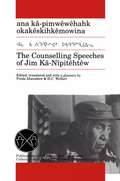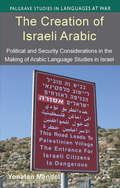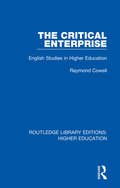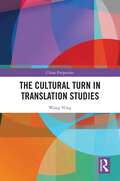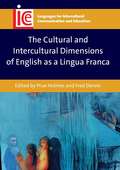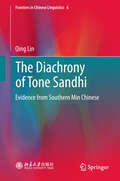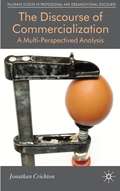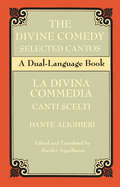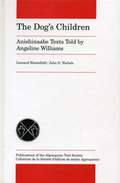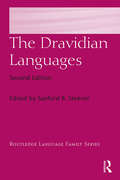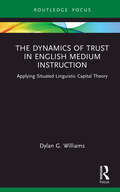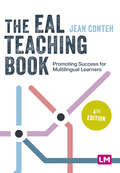- Table View
- List View
The Complete Idiot's Guide to Intermediate Spanish, 2nd Edition: Take Your Spanish Skills to the Next Level
by Steven HawsonThis revised edition offers expanded coverage of grammar and vocabulary, as well as idiomatic usage, irregular verbs, and conversational elements that will help readers improve their language skills in a variety of situations. In addition, a new workbook section specially designed to help readers practice and retain information has been included.• Includes a comprehensive review of beginning Spanish, plus simple strategies for memorizing cases, endings, and vocabulary• Features an easy-to-understand guide to Spanish idioms• Covers business and medical Spanish• Techniques for mastering vocabulary and grammar• New exercises and answers throughout
The Complete Idiot's Guide to Learning German, 4E
by Lisa Graham Alicia Muller Stephan MullerThis comprehensive guide to mastering the German language presents often difficult-to-master information, such as verb tenses, in the approachable Complete Idiot's Guide® format. Readers will discover useful travel-themed chapters, dealing with everything from shopping, renting cars, and making a phone call, to visiting a doctor, going to the post office, and banking. With information on the essentials of German grammar, vocabulary, pronunciation, and conversation, this new edition also includes a supplemental CD with nearly an hour of listen-and-learn exercises that can be used either with or without the book.
The Complete Idiot's Guide to Learning Italian, 3rd Edition
by Gabrielle EuvinoLearn the language of la dolce vita!For anyone who wants to learn and enjoy the most expressive and romantic of languages, the third edition of The Complete Idiot&’s Guide® to Learning Italian is the first choice for a whole new generation of enthusiastic students of Italian. This updated edition includes two new quick references on verbs, grammar, and sentence structure; two new appendixes on Italian synonyms and popular idiomatic phrases; and updated business and money sections. • First two editions have sold extraordinarily well • Italian is the fourth most popular language in the United States
The Complete Idiot's Guide to Learning Latin, 3rd Edition: A Modern Approach to Grammar, Vocabulary, and Everything You Need to Read and Sp
by Natalie HarwoodAn updated guide to the language of the Roman Empire. Whether interested in learning Latin or just seeking a deeper understanding of English, readers will find a fun alternative to the standard dusty tomes usually associated with Latin. Included in this revised edition are updated vocabulary lists relevant to today&’s world, expanded pronunciation guides, Latin–to–English and English–to–Latin translations, and a workbook of exercises, reading passages, and tools for greater comprehension of the language. • In 2002, the number of high school students taking Latin tests for college credit had risen 95% since 1993 • According to CNN, educators are increasingly turning toward Latin to improve student performance in reading, math, and science • Perfect reference tool for law school, medical school, music school, and other graduate school students faced with getting through a Latin course as a requirement
The Complete Idiot's Guide to Para Aprender Ingles
by D.H. Figueredo Margaret FernandezMillions of Spanish-speaking immigrants enroll in ESL (English as a Second Language) classes every year. This curriculum-based guide offers practical examples, exercises, and quizzes to quickly and effectively bolster English skills.
The Complete Japanese Expression Guide
by Mizue SasakiA companion volume to The Complete Japanese Verb Guide andThe Complete Japanese Adjective Guide, with over 600 idioms.The Complete Japanese Expression Guide enables students to speak and understand idiomatic Japanese with the ease and fluency of a native speaker. For the first time ever, over 600 of the most commonly used idiomatic expressions in the Japanese language have been brought together and alphabetized in a single, convenient volume. No longer will the student have to rely on stuffy academic-sounding phrases and expressions. Mizue Sasaki has successfully taken stilted formality out of Japanese, and made natural, idiomatic communication readily possible. This handy volume not only introduces essential idioms, but also provides easy-to-understand translations and numerous example sentences to show how the expressions should be used. Studying colloquial Japanese doesn't have to be hitori-zumo, a futile effort (page 94). With The Complete Japanese Expression Guide, fluency is guaranteed.
The Complete Japanese Verb Guide
by Hiroo Japanese CenterThe Complete Japanese Verb Guide is a handy, easy-to-use guide to one of the building blocks of language learning—verbs. To effectively learn Japanese, a strong knowledge of Japanese grammar and vocabulary is needed. This book will come to the rescue as it shows learners how to conjugate the 600 most common Japanese verbs quickly, and with very little effort. This is the only guide to list all verb forms in both Japanese script and romanized form, while giving an accurate English translation for each conjugated form, making this book far more comprehensive than any other book on the subject. Compiled by Japanese language experts at The Hiro Japanese Center, more than 30 different verbal forms are given for each verb including all forms used in contemporary spoken, written, formal and conversational Japanese—making this the ideal reference when reading any sort of Japanese printed materials including manga, newspapers, magazines and books. The Complete Japanese Verb Guide places an expert resource at your fingertips, giving you the information you need to speak, read, and write Japanese sentences correctly. Key features of this book are: Includes all the most useful verbs and Kanji (logographic Chinese characters) in Japanese, including less common ones. A wealth of example sentences are given to demonstrate correct verb usage. Over 30 forms are given for each verb including polite or formal, plain, negative, potential, conditional, passive, causative, and many more. Both Kana, Japanese script, and romanized forms are given for each entry. An ideal study guide for the standard Advanced Placement college test and the Japanese Language Proficiency Exam. Special sections are devoted to compound verbs and suru verbs such as Kaimono suru (to shop), benkyo suru (to study), and much more .
The Complete Latin Course
by G D SharpleyThe Complete Latin Course is a comprehensive introduction to Latin for students and armchair enthusiasts alike. This modern, user-friendly text offers a series of fascinating glimpses into the world of ancient Rome, and sets you up to read Virgil, Cicero, Juvenal, Tacitus and many other authors in the original Latin. The story of Rome is told by the ancient authors themselves. Authentic texts help to guide the student through the mechanics of Latin, whilst giving insights into the history of Rome, her culture and society, her gods, her games, her power struggles and the eventual fall of empire. Originally published as Essential Latin, this extensively revised and expanded second edition features: Reading passages from Latin prose authors, including Cicero, Petronius, Pliny, Sallust, Suetonius and Tacitus, and from poets (Catullus, Horace, Juvenal, Martial, Ovid and Virgil) with guidance on reading aloud and meter. A detailed step-by-step approach to Latin grammar, with engaging activities and exercises. A companion website with a full answer key for exercises, translations, grammar reference tables for the USA, the UK, Europe and elsewhere, additional exercises, word lists and other supports: http://www.lingua.co.uk/latin/materials/complete-latin Ideal for classroom use or independent study, The Complete Latin Course will prove an invaluable resource for undergraduate and postgraduate students, adult learners and anyone interested in comprehensively developing their knowledge of Latin.
The Conceptualization of Guardianship in Iranian Intellectual History: Reading Ibn ʿArabī’s Theory of Wilāya in the Shīʿa World (Palgrave Series in Islamic Theology, Law, and History)
by Leila ChamankhahThis book is a study of the concept of wilāya and its developments among Shīʿī scholars from the eighteenth to twentieth century. Leila Chamankhah addresses a number of issues by delving into the conceptualizations of wilāya through the examination and interpretation of key texts. She focuses on the influence of ibn ʿArabī’s mysticism, with regard to the conception of wilāya, on his Shīʿa successors and expositors in later centuries. She also discusses the development and transformation of the conception of wilāya over two hundred years, from the esoteric school of Shaykhīsm to the politicization of wilāya in the theory of wilāyat al-faqīh.
The Concise New Partridge Dictionary of Slang and Unconventional English
by Tom Dalzell Terry VictorThe Concise New Partridge Dictionary of Slang and Unconventional English presents all the slang terms from The New Partridge Dictionary of Slang and Unconventional English in a single volume. Containing over 60,000 entries, this concise new edition of the authoritative work details the slang and unconventional English of from around the English-speaking world since 1945, and through the first decade of the new millennium, with the same thorough, intense, and lively scholarship that characterized Partridge’s own work. Unique, exciting and, at times, hilariously shocking, key features include: unprecedented coverage of World English, with equal prominence given to American and British English slang, and entries included from Australia, New Zealand, Canada, India, South Africa, Ireland, and the Caribbean emphasis on post-World War II slang and unconventional English dating information for each headword in the tradition of Partridge, commentary on the term’s origins and meaning. New to this second edition: a new preface noting slang trends of the last eight years over 1,000 new entries from the US, UK and Australia, reflecting important developments in language and culture new terms from the language of social networking from a range of digital communities including texting, blogs, Facebook, Twitter and online forums many entries now revised to include new dating and new glosses, ensuring maximum accuracy of content. The Concise New Partridge Dictionary of Slang and Unconventional English is a spectacular resource infused with humour and learning – it’s rude, it’s delightful, and it’s a prize for anyone with a love of language.
The Corrections (Mandarin Edition)
by Jonathan FranzenAfter almost fifty years as a wife and mother, Enid Lambert is ready to have some fun. Unfortunately, her husband is losing his sanity to Parkinson's disease, and their children have long since flown the family nest to the catastrophes of their own lives. Desperate for some pleasure to look forward to, Enid has set her heart on an elusive goal: bringing her family together for one last Christmas at home 伊妮德·兰伯特 当了五十年的妻子和母亲之后 准备让自己享受一下快乐 不幸的是 她的丈夫 艾尔弗雷德罹患帕金森症 逐渐精神失常 他们的孩子也早已飞出了家庭的小巢 奔向各自生活的悲剧 大儿子加里 银行的投资经理,居家男人 正努力说服自己和家人他没有临床抑郁症----尽管各方面证据相反 二儿子奇普 因性丑闻失去了高校的稳定工作 处于半失业状态 指望着靠手头的剧本赚钱 三女儿丹妮丝年轻美貌 逃离了惨淡的婚姻 成了纽约高级餐厅的主厨 却与一位已婚男性有染----至少她母亲如此怀疑 尽管情势看起来无比绝望 伊妮德却意志坚定 她要纠正一切的错误 享受全家人的最后一次圣诞欢聚
The Counselling Speeches of Jim Ka-Nipitehtew (Algonquian Text Society)
by Jim Kâ-NîpitêhtêwJim Ka-Nipitehtew was a respected Cree Elder from Onion Lake, Saskatchewan, who spoke only Cree and provided these original counselling discourses. The book offers the speeches in Cree syllabics and in Roman Orthography as well as an English translation and commentary. The Elder offers guidance for First Nations people in these eight speeches that cover the proper performance of ceremonies, words of encouragement for youth, information about collecting medicinal plants, directions for proper behaviour of men toward women, proper preparations for the Pipe ceremony, the role of the Pipestem in the Making of Treaty 6, the importance of tobacco, and examples of improper ritual behaviour in ceremonies. One of the most important speeches is the narrative of the Cree record for the treaty negotiations that took place in the summer of 1876. It was originally transmitted by Jim Ka-Nipitehtew's father directly to him and the authors comment on this remarkable chain of transmission. The book contains a Cree-English and an English-Cree Glossary. This is an important resource for Cree linguistics as well as those interested in understanding the Cree perspective of Treaty 6.
The Creation of Israeli Arabic
by Yonatan MendelThis book sheds light on the ways in which the on-going Israeli-Arab conflict has shaped Arabic language instruction. Due to its interdisciplinary nature it will be of great interest to academics and researchers in security and middle eastern studies as well as those focused on language and linguistics.
The Critical Enterprise: English Studies in Higher Education (Routledge Library Editions: Higher Education #5)
by Raymond CowellOriginally published in 1975, The Critical Enterprise looks at how the expansion and diversification of English Studies was shaping and was shaped by the Higher Education curriculum. The book looks at how students of sixth forms, colleges, polytechnics and universities alike found an increasing emphasis on interdisciplinary studies and how this opened new ways of studying new subjects. The book defines the unique academic elements which make English Studies a unique academic experience as well as an essential ingredient of most interdisciplinary courses.
The Cultural Turn in Translation Studies (China Perspectives)
by Wang NingApplying the latest Western translation theories to the situation in China, this book redefines translation from an interdisciplinary and intercultural perspective, bringing intercultural semiotic translation into the sight of translation researchers. The book systematically expounds on the cultural turn in translation studies, and contributes to the escape of translation studies from the "cage of language". It focuses on discussing the deconstructive, post-modernist, and cultural translation theories that have motivated and promoted the cultural turn, especially Benjamin’s translation theory, Derrida’s deconstructive view of translation, and post-colonial translation theory. It also discusses in detail the theories of major international translation theorists, including Hillis Miller, Wolfgang Iser, Edward Said, Gayatri Spivak, Homi Bhabha, André Lefevere, Susan Bassnett, and Lawrence Venuti. These theories are mostly based on examples from Western or English-language texts, leaving a wide gap in the discourse of the field. This book seeks to fill that gap. For example, intercultural semiotic translation is defined and explained through the successful experiences of the Chinese translator Fu Lei. The role of translation during the Chinese revolution and the relocation of Chinese culture in the global cultural landscape through translation are also discussed. This book will be an essential read to students and scholars of translation studies and Chinese studies. It will also be a useful resource for translators and researchers of comparative literature and cultural studies.
The Cultural and Intercultural Dimensions of English as a Lingua Franca
by Fred Dervin Prue HolmesThis book investigates the cultural and intercultural aspects of English as a Lingua Franca (ELF). Authors discuss how 'culture' and the 'intercultural' can be understood, theorised and operationalised in ELF, and how the concepts can be integrated into formats of ELF-oriented learning and teaching. The various cultural connotations are also discussed (ideological, political, religious and historical) and whether it is possible to use and/or teach a lingua franca as if it were culturally neutral. The chapters consider the communication and pedagogical implications of the cultural and intercultural dimensions of ELF and offer suggestions for new directions in ELF research, pedagogy and curriculum development.
The Desert Is My Mother / El Desierto Es Mi Madre
by Pat MoraThis beautifully written and illustrated book will inspire children with its artistry, imagination, and spirit. A young girl embarks on a poetic journey through the desert, discovering the many gifts that nature offers. Text copyright 2004 Lectorum Publications, Inc.
The Diachrony of Tone Sandhi: Evidence from Southern Min Chinese (Frontiers in Chinese Linguistics #6)
by Qing LinThis book investigates the diachronic change of the tone sandhi of Southern Min Chinese, which is known for its synchronic arbitrariness and opacity. It argues that in final-prominent tone sandhi, the change of final tones and the change of non-final tones can be highly independent and essentially different from each other. Accordingly, it proposes a new position-based diachronic approach to study the separate evolution of tones occurring at different positions. This book is the first study to rigorously and systematically explore the diachrony of Southern Min tone sandhi.
The Discourse of Commercialization
by Jonathan CrichtonAn examination of how the commercialization of professional practice is implicated in its organizational discourses. Drawing on a study of ELT colleges, the book explores how teaching practices are permeated and challenged by a 'discourse of commercialization' through which market priorities become normative in teachers' professional lives.
The Divine Comedy Selected Cantos: A Dual-Language Book (Dover Dual Language Italian)
by Stanley Appelbaum DanteBegun about 1307 and completed in 1321, Dante's sublime poetic masterpiece, The Divine Comedy, is one of the world's great works of literature. It comprises an extraordinarily vivid and imaginative account of the poet's allegorical journey through the afterlife. Complementing its depiction of the world beyond, the poem's abundant allusions to earthly history and politics, vivid portrayals of Dante's friends and enemies, and many references to contemporary Italian affairs make it an intensely human, realistic portrait of life on earth. Led in his travels by the classical poet Virgil, Dante descends through the nine circles of Hell, where punishment is determined by the gravity of the sinner's transgressions. He then ascends the mountain of Purgatory, encountering souls atoning for their misdeeds, and, at the summit, is met at the entrance to Paradise by Beatrice, his beloved. Throughout his pilgrimage, he meets characters drawn from ancient Roman and medieval times (philosophers, heroes, emperors, popes, and politicians, among others) as well as numerous personalities from the Italy of his day. This dual-language edition includes the complete texts of 33 of the original 100 cantos or "songs"; each omitted canto is summarized in its proper place to provide continuity. The selection of cantos and the excellent line-for-line translations from Italian into English are by Stanley Appelbaum, who also has provided an informative Introduction and useful notes.
The Dog's Children: Anishinaabe Texts told by Angeline Williams (Algonquian Text Society)
by Leonard Bloomfield Angeline Williams John D. NicholsThese are a collection of 20 stories, dictated in 1941 to Bloomfield's linguistics class, edited from manuscripts now in the National Anthropological Archives at the Smithsonian Institution, and published for the first time. In Ojibwe, with English translations by Bloomfield. Ojibwe-English glossary and other linguistic study aids.
The Dravidian Languages (Routledge Language Family Series)
by Sanford B. SteeverThe Dravidian language family is the world's fourth largest with nearly 250 million speakers across South Asia from Pakistan to Nepal, from Bangladesh to Sri Lanka. This authoritative reference source provides a unique description of the languages, covering their grammatical structure and historical development, plus sociolinguistic features. Each chapter combines a modern linguistic perspective with traditional historical linguistics, and a uniform structure allows for easy typological comparison between the individual languages. New to this edition are chapters on Beṭṭa Kuṟumba, Kuṛux, Kūvi and Malayāḷam, and enlarged sections in various existing chapters, as well as updated bibliographies and demographic data throughout.The Dravidian Languages will be invaluable to students and researchers within linguistics, and will also be of interest to readers in the fields of comparative literature, areal linguistics and South Asian studies.
The Dravidian Languages (Routledge Language Family Series)
by Sanford SteeverThe Dravidian language family is the world's fourth largest with nearly 250 million speakers across South Asia from Pakistan to Nepal, from Bangladesh to Sri Lanka. This authoritative reference source provides a unique description of the languages, covering their grammatical structure and historical development, plus sociolinguistic features. Each chapter combines modern linguistic perspective with traditional historical linguistics, and a uniform structure allows for easy typological comparison between the individual languages. New to this edition are chapters on Beṭṭa Kuṟumba, Kuṛux, Kūvi and Malayāḷam, enlarged sections in various existing chapters, as well updated bibliographies and demographic data throughout. The Dravidian Languages will be invaluable to students and researchers within linguistics, and will also be of interest to readers in the fields of comparative literature, areal linguistics and South Asian studies.
The Dynamics of Trust in English Medium Instruction: Applying Situated Linguistic Capital Theory (Routledge Focus on English-Medium Instruction in Higher Education)
by Dylan WilliamsThis book explores South Korean university students’ perceptions of the English Medium Instruction (EMI) courses they have taken. It specifically examines how the interplay of linguistic capital and trust shapes their EMI experiences.In South Korea, the implementation of neoliberal EMI policies, driven by a 'top-down' approach, has failed to adequately address the linguistic challenges faced by stakeholders. The setting for the book is a research-intensive university, where data were collected from ten engineering and business students through semi-structured interviews and analysed using Constructivist Grounded Theory (CGT), enabling a grounded understanding of the students’ perceptions. The areas investigated are students’ perceptions of their past experiences, of their access to subject content, and of how interactions take shape in their EMI experiences. Emerging from the analysis is a dynamic between trust and linguistic capital, which has been shaped by the past and which affects the future, leading to epistemic outcomes. The results indicate that monolingually framed trust in situated-linguistic codes plays a role in the students’ EMI experiences, and from this ‘Situated-Linguistic Capital Theory’ emerges. The theory indicates that monolingually framed trust reinforces binary choices, in particular EMI situations, of using either the L1 or the L2 system, which can lead to potential epistemic outcomes. The book concludes with a discussion of the factors that can determine the future success of EMI in South Korea.This volume will be of interest to researchers and postgraduate students examining English Medium Instruction and its success in different higher education contexts.
The EAL Teaching Book: Promoting Success for Multilingual Learners (Primary Teaching Now)
by Jean ContehAs the number of children for whom English is an Additional Language in schools increases, how do teachers and trainees prepare to support them to succeed? A complete guide to understanding, learning from and teaching bilingual and EAL children in schools. The text begins by asking ′who are EAL learners′ and challenges some of the misconceptions about this group. It goes on to examine language in depth, providing focused theory to help teachers and trainees better understand the wider context of children′s needs. This theory is supported by a wealth of information on practical teaching strategies and resources in the promoting learning section. The text covers planning across the curriculum for EAL and offers day-to-day practical support for teachers. The fourth edition is updated throughout and includes a new chapter on EAL and SEND.
